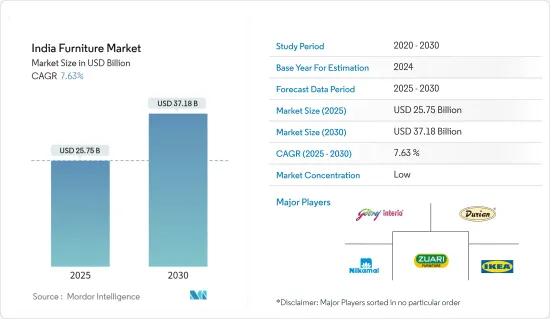PUBLISHER: Mordor Intelligence | PRODUCT CODE: 1689857

PUBLISHER: Mordor Intelligence | PRODUCT CODE: 1689857
India Furniture - Market Share Analysis, Industry Trends & Statistics, Growth Forecasts (2025 - 2030)
The India Furniture Market size is estimated at USD 25.75 billion in 2025, and is expected to reach USD 37.18 billion by 2030, at a CAGR of 7.63% during the forecast period (2025-2030).

The furniture market in India has evolved. The rise of the Indian furniture market is facilitated by an increase in middle-class people, rising disposable income, and an increase in urban dwellings. India's unorganized small local businesses dominate the country's furniture sector. However, during the past ten years, organized players have expanded their participation in the Indian furniture market. Urbanization of Indian states, the increasing demand for durable and hybrid sitting furniture, and the rising demand for modular and cutting-edge furniture are all factors driving the expansion of the furniture business in the country. The flourishing Indian wood industry also contributes to reducing the price of furniture. These factors are expected to boost the growth of the furniture market in the country.
Furthermore, there is expected to be a rise in demand for furniture through online channels due to the increasing acceptance of mobile and internet shopping in India. The tourism and hospitality sector, as well as the corporate sector, are also driving the expansion of the Indian furniture market. The rise in hotels and corporate offices further fuels the country's demand for furniture.
India Furniture Market Trends
Changing Consumer Preferences are Fueling the Market Growth
Consumer preferences have altered as Western culture's impact has grown. The demand for adaptive and stylish furniture has increased in India's metropolitan cities. The fast rise of metropolises and the development of the housing sector are transforming people's living standards and lives. Furthermore, as consumers grow more conscious of the importance of sustainability and recycling, they make more informed purchasing selections, preferring engineered wood furniture/refurbished furniture over plastic furniture. As a result, to fulfill expanding consumer demand, furniture producers are continually producing creative and ecological goods.
Rise in Adoption of Home Decor is Fueling the Market
With the growth of the Indian economy, disposable incomes have been on the rise. This has led to an increase in purchasing power and the ability of individuals to spend more on home decor, including furniture. Shifting lifestyles and rapid urbanization have led to a change in consumer preferences. There is a growing emphasis on creating aesthetically pleasing and well-designed living spaces. As a result, people are investing more in home decor and furniture to enhance their homes' overall look and feel. Home improvement shows and interior design magazines have gained significant viewership in India. The growth in the real estate sector, including residential and commercial projects, has created a demand for furniture. New homes, apartments, and office spaces require furnishing, leading to increased sales in the furniture market.
India Furniture Industry Overview
The Indian furniture market is highly competitive and fragmented, with fewer market players than the unorganized market players. The key players in the market include Godrej, Zuari, Durian, Nilkamal, and Featherlite. However, due to low entry barriers, several new players are expected to enter this market.
Additional Benefits:
- The market estimate (ME) sheet in Excel format
- 3 months of analyst support
TABLE OF CONTENTS
1 INTRODUCTION
- 1.1 Study Assumptions and Market Definition
- 1.2 Scope of the Study
2 RESEARCH METHODOLOGY
3 EXECUTIVE SUMMARY
4 MARKET INSIGHTS
5 MARKET DYNAMICS
- 5.1 Market Overview
- 5.2 Market Drivers
- 5.2.1 Growing Urbanization is Driving the Market
- 5.2.2 Increase in Rising Disposable Income
- 5.3 Market Restraints
- 5.3.1 Price Sensitivity is a Significant Challenge in the Indian Furniture Market
- 5.4 Market Opportunities
- 5.4.1 E-commerce and Digital Adoption
- 5.5 Industry Value Chain Analysis
- 5.6 Industry Attractiveness: Porter's Five Forces Analysis
- 5.6.1 Threat of New Entrants
- 5.6.2 Bargaining Power of Buyers
- 5.6.3 Bargaining Power of Suppliers
- 5.6.4 Threat of Substitutes
- 5.6.5 Intensity of Competitive Rivalry
- 5.7 Insights into Technological Innovations in the Furniture Industry
- 5.8 Insights into Consumer Preferences for Furniture Products in the Country
- 5.9 Impact of COVID-19 on the Market
6 MARKET SEGMENTATION
- 6.1 Material
- 6.1.1 Wood
- 6.1.2 Metal
- 6.1.3 Plastic and Other Furniture
- 6.2 Type
- 6.2.1 Home Furniture
- 6.2.2 Office Furniture
- 6.2.3 Hospitality Furniture
- 6.2.4 Other Furniture
- 6.3 Distribution Channel
- 6.3.1 Supermarkets/Hypermarkets
- 6.3.2 Specialty Stores
- 6.3.3 Online
- 6.3.4 Other Distribution Channels
7 COMPETITIVE LANDSCAPE
- 7.1 Market Competition Overview
- 7.2 Company Profiles
- 7.2.1 Godrej Interio
- 7.2.2 Zuari Furniture
- 7.2.3 Durian
- 7.2.4 Usha Lexus Furniture
- 7.2.5 Damro
- 7.2.6 Evok
- 7.2.7 Ikea
- 7.2.8 Hulsta
- 7.2.9 Wipro Furniture
- 7.2.10 Nilkamal Furniture
- 7.2.11 Other Prominent Companies (Dynasty, Featherlite, Omfurn India Ltd, Pepperfry, and Urban Ladder, etc)*
8 FUTURE OF THE MARKET
9 DISCLAIMER AND ABOUT US




